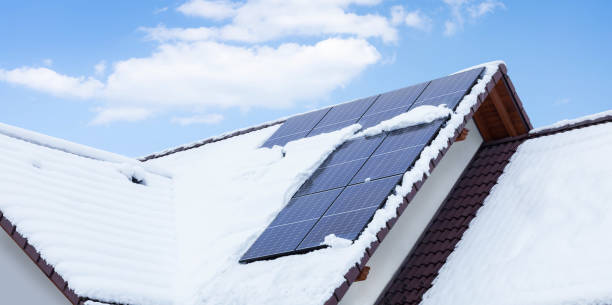Who Makes the Highest Snow Load Solar Panels?
When selecting solar panels for areas with heavy snowfall, durability and load capacity become critical factors. Snow accumulation can place immense stress on solar panels, potentially leading to damage or reduced efficiency. So, who makes the highest snow load solar panels? Leading manufacturers like LG, Panasonic, REC, SunPower, Canadian Solar, and Q CELLS produce robust, snow-load-tested solar panels capable of withstanding extreme winter conditions. This blog delves into their offerings and helps you choose the best option for high-snowfall regions.
What Is Snow Load and Why Does It Matter for Solar Panels?
Snow load refers to the weight exerted by accumulated snow on a surface, measured in pounds per square foot (psf). Solar panels installed in areas prone to heavy snowfall must endure this weight without cracking, bending, or losing efficiency. High snow load ratings ensure the structural integrity of the panel and prevent costly maintenance or replacements. Most manufacturers specify their panels’ snow load ratings in their datasheets, often ranging from 5000 to 8000 pascals (Pa).
Top Manufacturers Offering High Snow Load Solar Panels
- LG Electronics
- Key Features: LG’s solar panels are renowned for their durability and advanced technology. Models like LG NeON R have a snow load rating of up to 6000 Pa, making them ideal for areas with heavy snowfall.
- Technology Highlights: These panels feature reinforced frames and N-type cells that maintain efficiency under extreme conditions. The enhanced frame design minimizes the risk of damage from snow accumulation.
- Warranty: LG offers a 25-year product and performance warranty, ensuring reliability in harsh climates.
- Panasonic
- Key Features: Panasonic HIT panels are among the most efficient and durable options, boasting snow load ratings of up to 5700 Pa.
- Technology Highlights: Their heterojunction cell technology ensures high energy output even in low-light conditions, which is particularly useful in winter.
- Warranty: Panasonic provides a 25-year warranty, emphasizing their confidence in product longevity.
- REC Solar
- Key Features: REC Alpha Pure and TwinPeak models are engineered for resilience, with snow load ratings of up to 7000 Pa.
- Technology Highlights: REC panels use a split-cell design that reduces hotspots and ensures consistent performance under snow-covered conditions.
- Warranty: A 25-year product and performance warranty covers their panels, offering peace of mind.
- SunPower
- Key Features: SunPower Maxeon panels are celebrated for their unparalleled efficiency and robust construction. They feature snow load ratings of up to 6000 Pa.
- Technology Highlights: Their solid copper backing enhances panel strength, while high efficiency ensures maximum energy capture even in snowy conditions.
- Warranty: SunPower’s 40-year warranty is among the best in the industry, reflecting their panels’ durability.
- Canadian Solar
- Key Features: Canadian Solar’s HiKu and BiHiKu series panels are designed for durability, with snow load ratings of up to 7000 Pa.
- Technology Highlights: Their polycrystalline and monocrystalline options offer flexibility and consistent performance in heavy snowfall areas.
- Warranty: A 12-year product warranty and a 25-year performance warranty are standard with Canadian Solar panels.
- Q CELLS
- Key Features: Q CELLS’ Q.PEAK DUO series panels deliver impressive snow load ratings of up to 5400 Pa.
- Technology Highlights: The panels utilize half-cell technology and reinforced frames to withstand challenging winter conditions.
- Warranty: Q CELLS offers a 25-year product and performance warranty.
Factors to Consider When Choosing Solar Panels for Snowy Climates
- Snow Load Rating:
- Opt for panels with a snow load rating of at least 5000 Pa for high-snowfall areas.
- Frame Design:
- Panels with reinforced frames and corner protection are better suited for heavy snow conditions.
- Efficiency in Low-Light Conditions:
- Choose panels with high efficiency to maximize energy production during shorter winter days.
- Warranty:
- A long-term warranty indicates manufacturer confidence in the panel’s durability and performance.
- Mounting System Compatibility:
- Ensure that the mounting system is also designed for high snow loads to prevent structural failures.
Installation Tips for Snowy Areas
- Tilt Angle:
- Install panels at a steeper angle (35-45 degrees) to facilitate snow shedding.
- Snow Guards:
- Use snow guards to prevent large snow chunks from sliding off and causing damage.
- Regular Maintenance:
- Clear snow accumulation regularly to optimize energy production.
- Robust Mounting Structures:
- Invest in high-quality mounting systems that can bear heavy loads alongside the panels.
Conclusion
For those living in snowy regions, choosing solar panels with a high snow load rating is crucial. Manufacturers like LG, Panasonic, REC, SunPower, Canadian Solar, and Q CELLS lead the industry with robust and efficient options. Focus on key factors such as snow load ratings, frame design, and efficiency in low-light conditions to make an informed decision. With the right solar panels and installation techniques, you can enjoy reliable energy production even in the harshest winter conditions.

